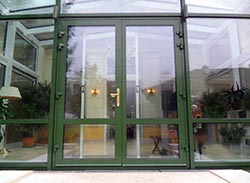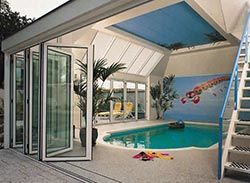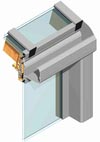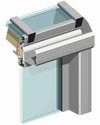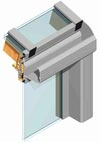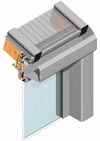Planning
I. Style and form
1. Aesthetics.
What suits our house? Form - Colour - Style
On the following pages, we present some beautiful examples of the relationship between a family house and a conservatory. I recommend that you look at as many conservatory photos as possible on the Internet or in newspapers, and after a while you will know what shape will be perfect for your house. We can also help you create a visual plan based on your idea.
In terms of colour, try to choose a colour that matches the colours of the house! We can choose the colour of the windows, the colour of the walls, the colour of the gutters or railings, but there must be something on the house that harmonizes with the conservatory. We always feel the beauty in the harmony of two or more things.
Our colour palette includes all RAL colours, 87 types of finely structured (fine-grained surface, matt and slightly glossy, easy-to-clean coating), 16 types of wood patterns, 2 types of concrete ('loft view') patterns and a special, rustic rust imitation.
The style can be chosen from 4 main types. We have 3 types of modern and 1 archaic Victorian style system. The choice is simple, which one do you like and which one suits the house? If you are not sure, a visual plan can help you decide again!
2. Function
What will we use the conservatory for?
The function could also be the first point, but it seems that the construction of the conservatory is definitely more than just a rational decision due to "there is not enough space" or "the terrace is unusable". For many, this is such a magical part of the apartment, which means a connection with the garden, plants, light, a kind of freedom, and they have long dreamed of such a Paradise-like place in their own home.
This can be the function itself: decoration of the apartment, with a small sofa set, lots of plants, where we can drink our morning coffee...
But the function is really important, as it determines the next steps: what and how much heating is needed, how to light the new space, whether there should be sufficient ventilation, how to shade... We can help with this based on our experience and technical assistance.
The following images show examples of standard and "extreme" functions:
function: cafe, reading or relaxing area
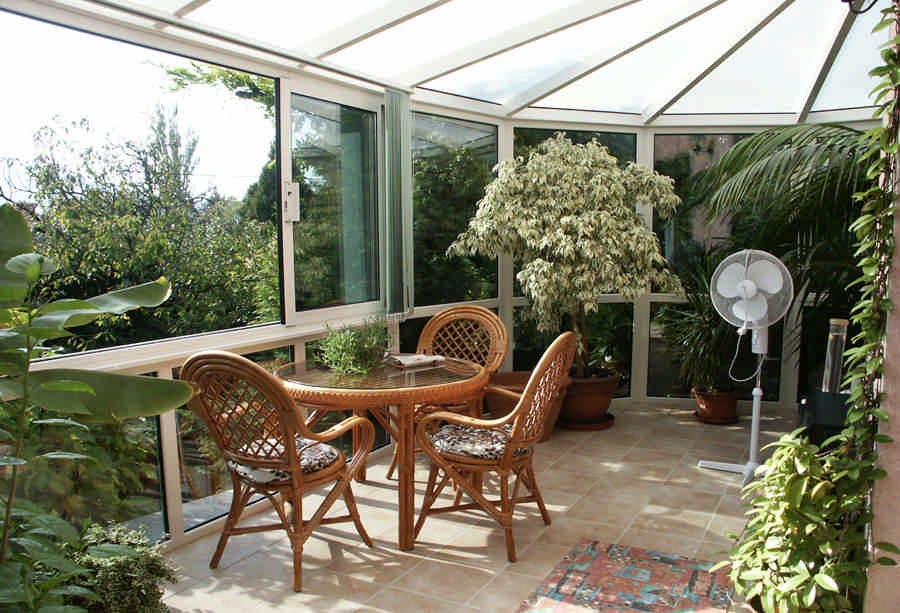
function: living room
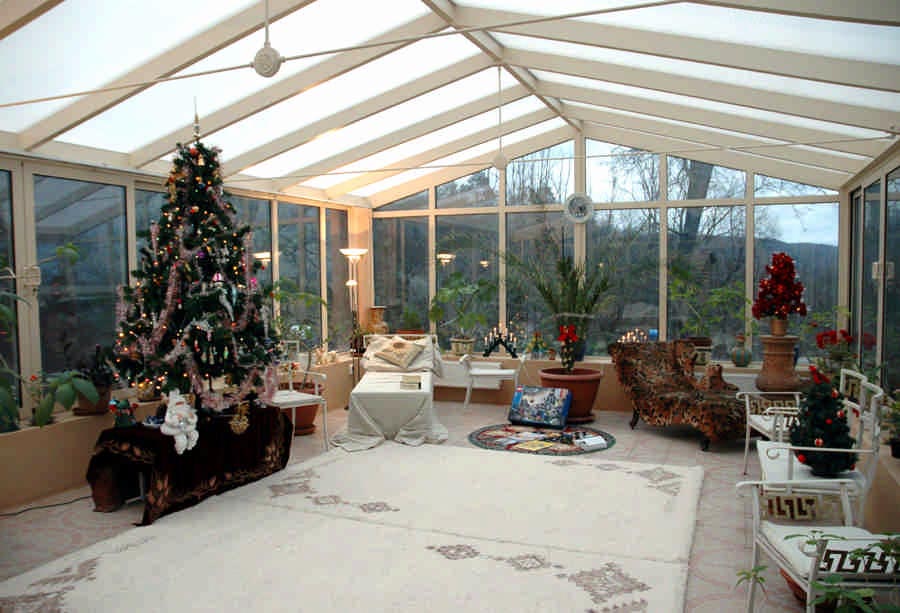
function: dining room
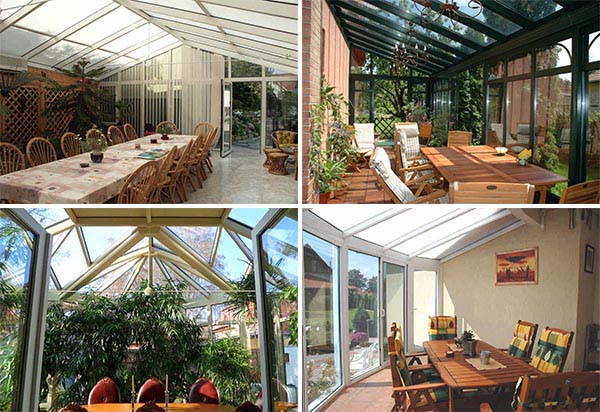
function: windbreak, porch
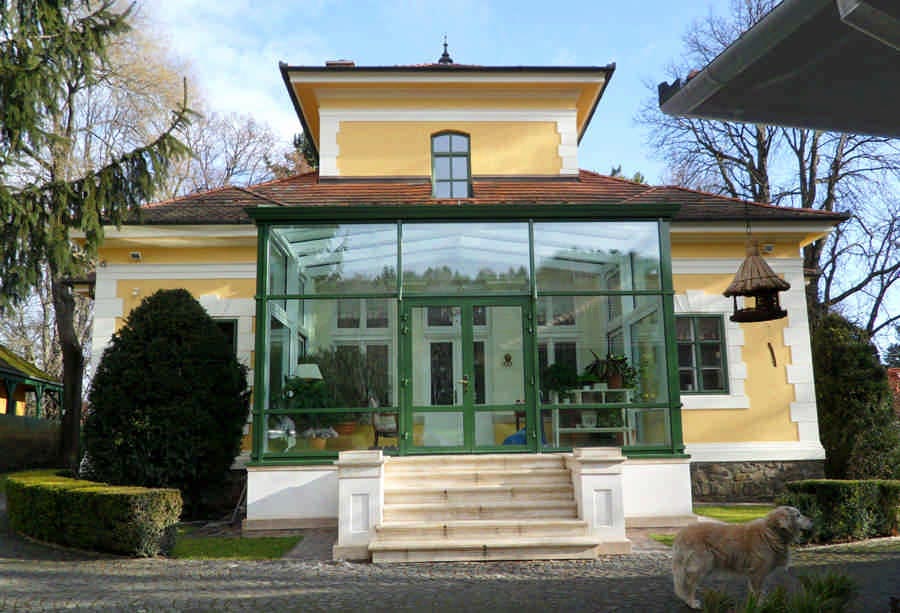
function: jacuzzi and sauna area connected to the house
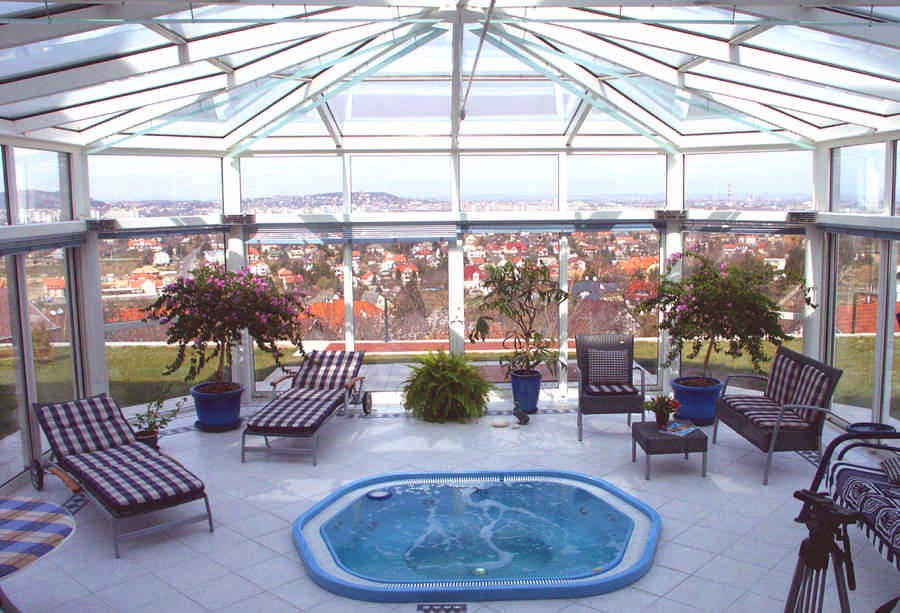
function: bathing erea with jacuzzi
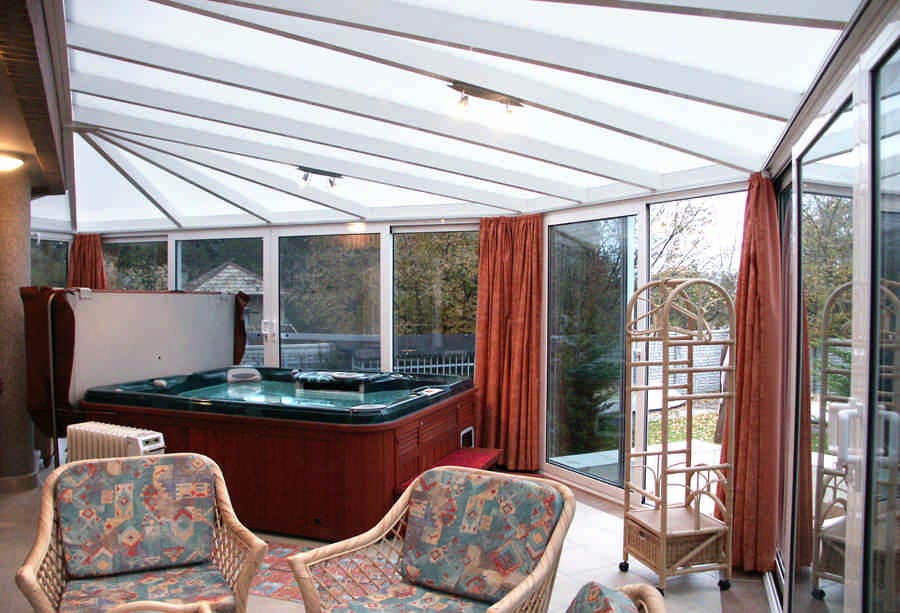
function: pool area
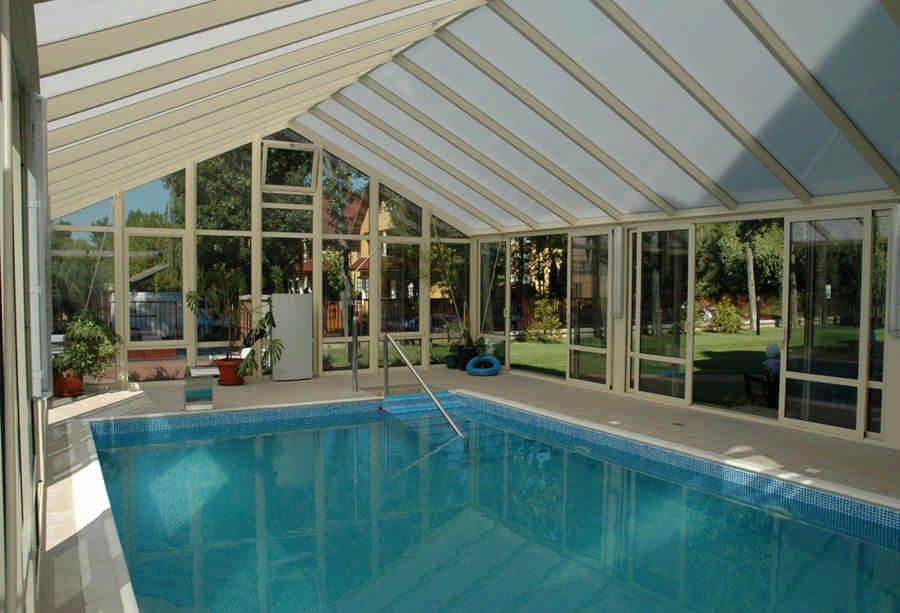
function: restaurant
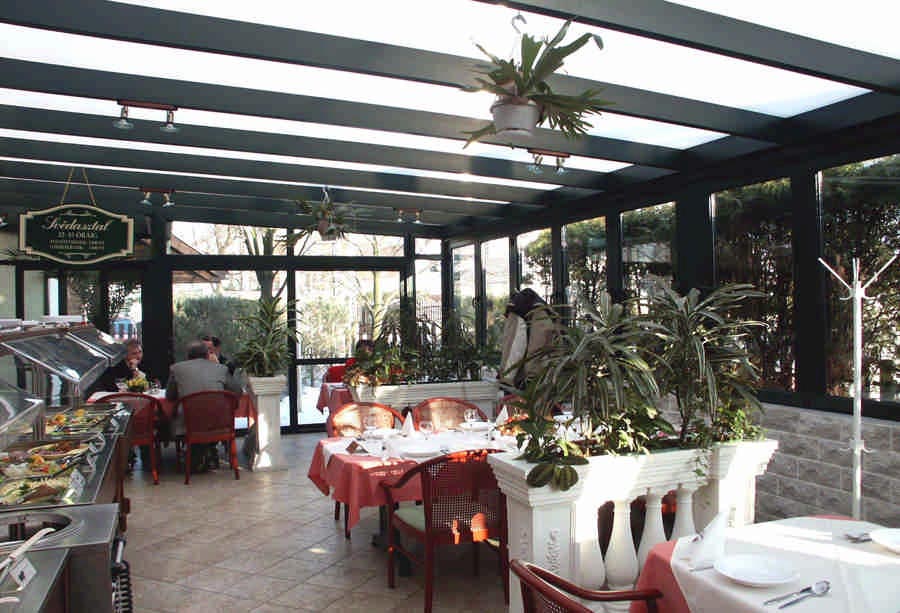
function: confectionery
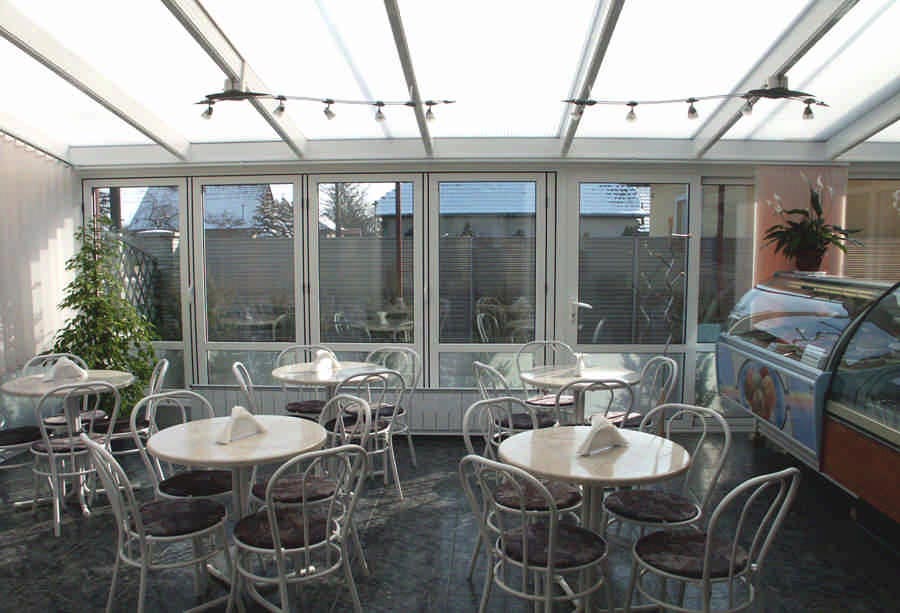
function: billiard room
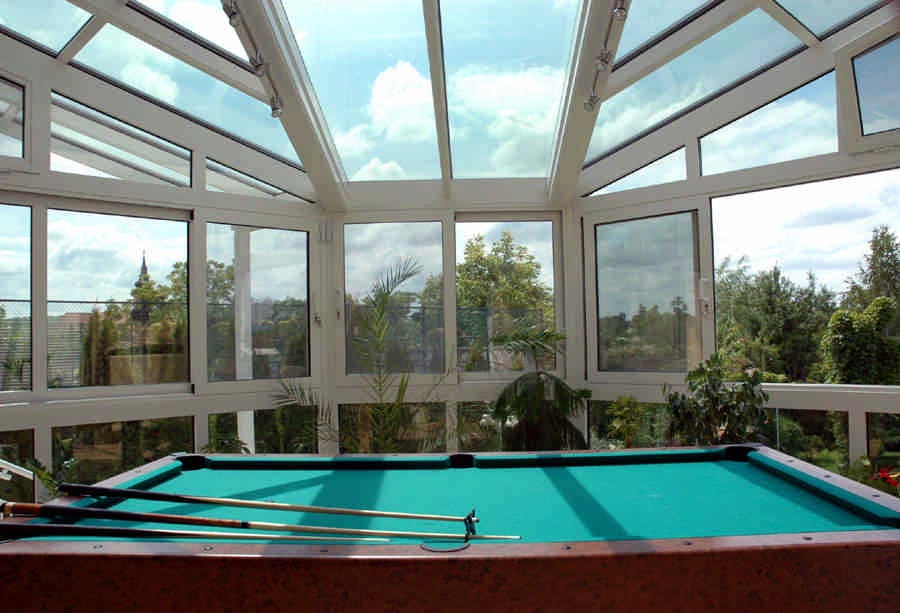
Additional functions can be, for example: fitness room, hairdressing salon, studio...
3. Material selection
We basically work with aluminium, as we consider this material to be the most durable and aesthetic, but all materials have their own advantages and disadvantages.
We have summarized these properties in the table:
| advantages: | disadvantages: | |
| plastic |
good thermal insulation; |
not durable, UV degrades the surface and "dusts", not load-bearing, only suitable for roof structures with an additional metal support frame, available in several colours |
| wood | good thermal insulation; natural; aesthetic |
its surface must be treated every few years; can warp; in quality design it is already very expensive; robust and less rigid |
| steel | high load capacity; cheaper than aluminium |
it rusts if it is not properly surface treated or if it is damaged; its painting "doesn't last forever", it must be periodically repainted; modest selection of profiles; thermally unfavourable |
| aluminium | durable, strong, aesthetic, rich selection of colours and surfaces; it does not rust |
the price point is higher; thermal technical parameters depending on quality - you must make sure that the profiles are free of thermal bridges. |
II. Thermal technology - feeling of comfort
4. Doors and windows
What kind? How many? Where to?
As many doors and windows as possible, preferably on all sides... Sliding doors are especially practical for conservatories!
| advantages: | disadvantages: | |
|
casement or tilt and turn window and door
|
The entire surface can be opened. Excellent air sealing; Can also be used with casement or pleated mosquito net. |
Wings take up space. The width of the wings is limited. |
|
Slide window and door
|
It slides in one plane, it does not take up space to open! They can also have wide, large wings! Optimal with a sliding mosquito net! Better pricing. |
Half surface can be opened. Its thermal insulation and air sealing are slightly lower than those of the casement ones. |
|
Accordion door, window
|
The entire surface can be opened. The wings can open outwards or inwards. Low threshold height. |
The thrust band of the wings must be left free, limited wing sizes. Higher price. |
5. Ventilation
Sufficient air movement and air exchange for feeling comfortable
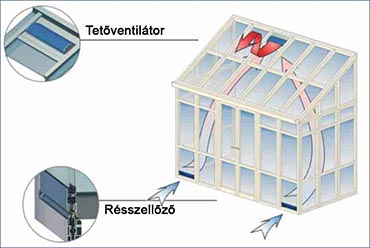
Ventilation can be ensured with the previously mentioned, adequate amount and well-placed windows and doors.
It is definitely worth putting an upper casement window at each end of the conservatory, which can be left open when we are not at home, so there is always a little air movement.
Adequate ventilation can be ensured even in the absence of natural air movement with the slot ventilators and motorized roof fan positioned as shown in the picture. Their type and required quantity can be planned using a table based on the size of the conservatory.
6. Heating
Types of heating for conservatories
The essence of heating in a conservatory is FLOWING warm air! The flowing warm air holds the water vapor, and the water vapor condenses out of the SAME TEMPERATURE, but STANDING air! You can try this with a fan if the glass is humid somewhere. You don't need to blow hot air on it, just move the air and it will be able to hold the moisture in again! This will even be better for our well-being, because dry air is not pleasant for the skin or breathing.
Conservatories, no matter what material they are made of, always have a large cooling surface, due to their significantly worse thermal insulation capacity than brick walls. For this reason, some of the heating methods used in the other rooms, such as underfloor heating or radiators, are not always satisfactory in the conservatory. The inner surface of brick walls with high thermal insulation capacity can never cool down to such a temperature that even the minimally heated, STANDING air would condense there. In the conservatory, on the other hand, the inner surface of the profiles and glass is "cool" despite the thermal insulation, so condensation can occur from the STANDING and not warm enough air.
We can do two things:
1.) We "overheat" the conservatory with a type of heating that produces static, i.e., stagnant air, because the steam does not condense out of the sufficiently warm, STANING air, and the strong heating also raises the inner side of the profiles to a higher temperature.
2.) We choose convection heating, i.e. heating that circulates warm air, such as the radiator shown in the pictures and the floor-mounted edge heater with fan.
7. Glazing
Glass types - Heat protection - Sun protection
Glass or polycarbonate cover?
|
The general type of glass for thermally insulated conservatories is 4 float – 16 we + Argon – 4 LowE composition glass, with a thermal insulation value of Ug = 1.0 W/m2K. In it, 2 pieces of 4 mm glass / with a 'plastic' spacer - so-called heat edge / are separated by a 16 mm air gap, which are filled with Argon gas to improve thermal insulation. The name LowE refers to a coating with low emissivity, i.e. low heat emission, which is placed on the side of the inner glass above the air gap, thus preventing the release of internal heat. The thermal insulation can be further increased with 3-layer, 4 LowE – 18 we + Ar – 4 float – 16 wr + Ar – 4 LowE composition glass, Ug = 0.5 W/m2K, so with a better thermal insulation value. (we: with warm edge technology) |
2 rétegű üveghezés |
|
Whether we need 3-layer glass in our conservatory depends on the function of the room and whether the higher profile and glass price pay off with lower heating costs. Roof glass differs from the above composition in that the inner glass is always laminated safety glass. The foil stuck between the two glasses holds the broken glass pieces together in the event of breakage, so they do not fall off. The outer layer of the roof glass can be hardened, which will not break even in the event of a serious hailstorm or an object falling on it. Because of the higher price, we only recommend this if the glass is difficult to replace or if there is a real risk of something falling on it from above |
3 rétegű üvegezés |
|
After thermal insulation and safety, one of the most important issues is sun protection. The large number of types that can be found on the market can be confusing, but the point is that the manufacturers can propose a solution for every need. The sun protection glass will be the outer layer of the insulating glass structure. It prevents heat rays from entering the conservatory and heating it up. They do this in several ways. There are those that have a reflective surface and reflect the heat rays, some that are coloured and absorb the heat rays, but don't let them through, and some that are non-reflective and not coloured, yet they can do everything the former do! So let's ask the manufacturer and choose according to the price-value ratio according to our wallet... |
üvegfedés |
|
One more important fact: No glass can replace shading if the conservatory is exposed to the sun all day and there are not enough windows that can be opened for ventilation. Sun protection glasses only protect 40-50-60% of the sun's radiation, which is a lot, but it only slows down the warming! Solar protection glass combined with the right amount of doors and windows may be sufficient in a moderately sunny location, but in other cases shading is also necessary if we want to use the conservatory every day of the year! Polycarbonate is often used in the roof instead of glass. The advantage is that a cheaper, weaker roof structure is sufficient, and we can also put up a 6-7 m long board, so there is no need for cross divisions in the roof. The downside is that it rattles in the rain, and you can't see clearly on it like on glass, because it has a cellular structure. It is the perfect solution for larger conservatories, swimming pools, and restaurants.
|
polikarbonát fedés |
8. Shading
Is it needed? - Outside or inside? - What type?
Whether you need a shade depends mainly on the orientation. If the conservatory receives strong afternoon sun and there are no trees or buildings to provide shade, we would definitely recommend a shade if it fits within the financial framework.
A NE-facing conservatory can often be used with sun protection glazing in the summer. The sun is shining in the morning, but by the time the real afternoon heat can develop, the structure is already in the shade, and with open doors and windows (with mosquito nets), it is a pleasant place to rest.
The many windows and doors are definitely useful. If the space can be ventilated, it's like being outside.
The name: winter garden, was not born by chance. Many people really only use it from autumn to spring, so that they can enjoy the atmosphere of the garden even in cool, rainy weather.
The four-season conservatory requires adequate heating, ventilation and shading!
If possible, choose external shading, because it is much more effective if the sun cannot even reach the outer surface of the glass, let alone the interior. On the roof, we recommend a motorized, canvas 'winter garden roof shade' that moves on rails in the plane of the roof.
We mainly shade the roof, if it fits into the price. For the side walls, we also recommend blinds and canvas side shading, but here there is a larger selection, i.e. blinds, shutters, or venetian blinds can also be safely used, taking into account aesthetics and functionality.
Canopy-type shades can be placed on the inner side of the roof if we would like to dim the direct, strong light. Within the side walls, reluxa is the most suitable shade, but we can also use blinds or even curtains (the cornice is an optional system accessory)
III. Economics
9. Size
If the dimensions are not given, how big should the conservatory be?
Most of the time, we build on ready-made terraces, but there may be cases when we have to decide on the size. From the point of view of the price, the number of profiles to be ordered for a conservatory is not insignificant. The factory length of most profiles is 7 m, so it is worth making maximum use of the thread. If the width only slightly exceeds 7 m, a new thread must be bought for this, and the splice line must be visible! Of course, we don't count on the price of even one whole strand in this case either, but it is more economical if we reduce the width of the conservatory to 7 m.
By definition, the depth of the conservatory is optimal if we can get two beams out of one strand at a size of around 3.5 m. If the depth is much greater, our modern system also has a 4.6m beam, so this is the next optimal limit.
As the size of the conservatory increases, the price does not increase in direct proportion! The larger a conservatory, the lower the price per m2, so if we increase the size keeping in mind the limits of profiles and load capacity, we can get cheap m2!
10. The most economical combination
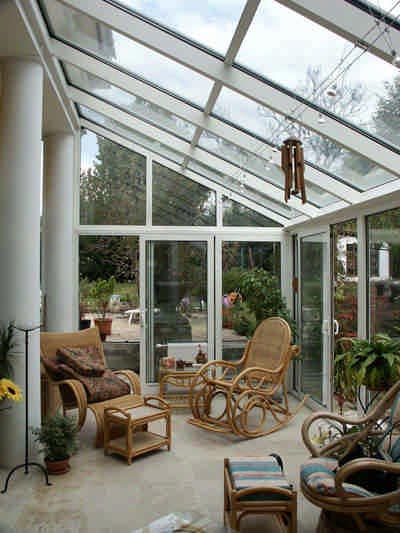 Shape: rectangle, with half-saddle roof as in the picture
Shape: rectangle, with half-saddle roof as in the picture
Style: modern, ribbed design
Colour: from basic colours (cca. 200 colours of RAL chart)
Doors: Tilt-and-casement windows that provide an optimal amount of ventilation; if necessary, one or two casement entrance doors, or sliding doors if a larger opening is required.
Heating: with radiators
Glazing: Side wall 4 float – 16 we – 4 LowE + Argon gas-filled insulating glass;
Roof 25 – 32 – 40 mm opal cell polycarbonate, or 6 float – 16 we + Argon – 44.1 VSG LowE, gas-filled heat insulating glass.
It is worth to use sun protection multifunctional glass (ClimaGuard® Solar water-clear type) for a small extra charge.
Shading: if the orientation makes it necessary, canvas shading, especially on the roof.
Floor plan dimensions: 3.5 x 7 m (width x length) maximum
ALIPLAST® wintergarden SYSTEM
-
Especially WINTERGARDEN systems
-
Ready node solutions
-
All connections can be solved with factory profiles and accessories
-
Concealed drainage
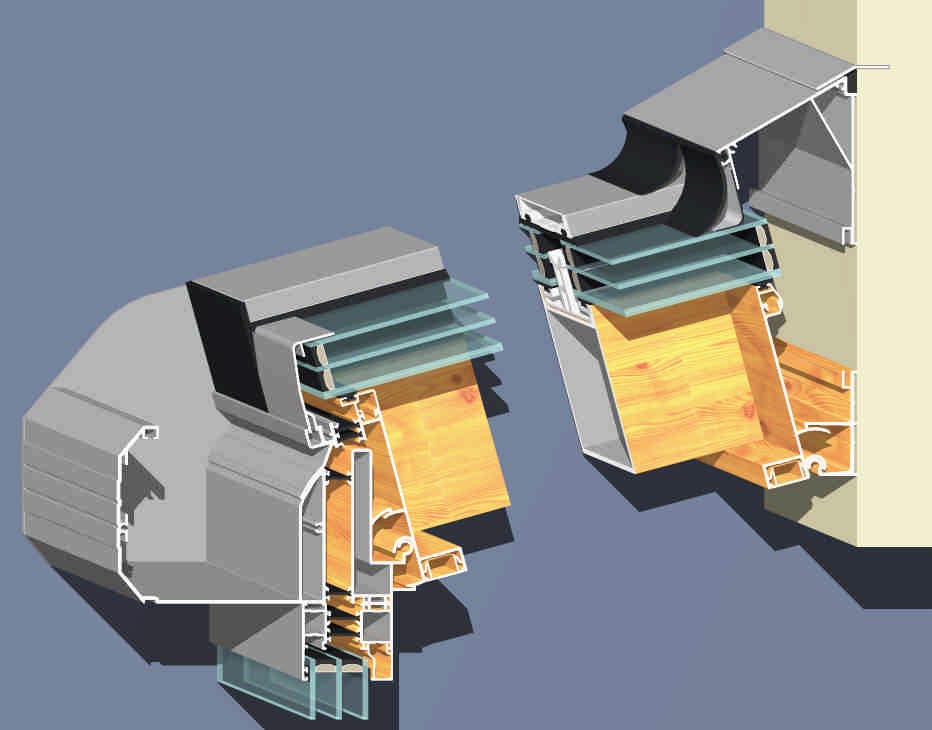
Advantages of a conservatory:
-
More practical than a terrace that is cold and slippery in winter, too hot in summer, windy and rainy...
-
Plants can be overwintered here.
-
Extra space for the apartment - new room, dining room, community space...
-
A new room with usability of a full apartment; Ur = 1.0 W/m2K resulting thermal insulation value is also available.
-
Can be used all year round with optimal ventilation and adequate shading.





